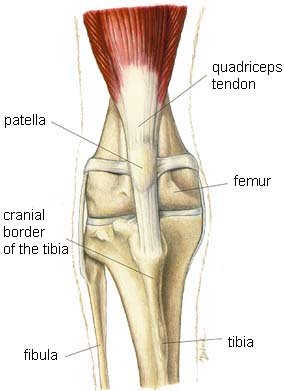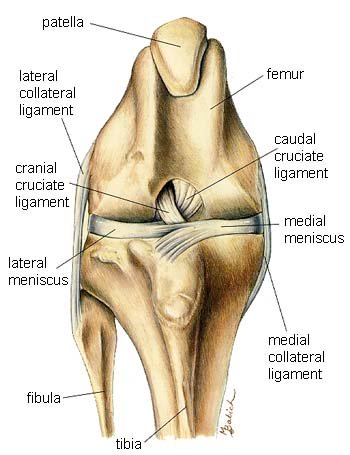Dog Knee Injuries
" Dog knee injuries are mostly related with the tearing of ligaments (fibrous tissues) and the displacement of bony features, especially the patella (dog knee cap). These injuries are characterized by general symptoms such as pain, limping, lameness and the raising of the leg while walking. A locked knee joint, rearward leg extension, an extended leg during walking or sitting and failure in the flex of the knee joint are some specific signs of dog knee injury along with general symptoms. The condition is confirmed through a physical examination and detailed radiography. Treatment depends upon the nature of dog knee injury. The condition requires immediate veterinary attention. Surgery and other types of medical intervention are applied individually or in combination to treat the condition. Supportive supplements can be used to help during long term recovery. "
Anatomy of the Dog Knee:
A Dog knee includes the joint, which connects three different bones;
- Femur: A dog femur is also called the thigh bone, which connects the knee to the dog hip.
- Tibia: The dog tibia is also called the canine shin-bone and it forms part of the leg. It connects the knee to the dog ankle.
- Patella: The patella is also called the “dog knee cap." It not only protects the knee joint, but also restricts the back and forth movement of the tibia and the femur during walking.

Dog Knee Anatomy (Stifle)
Ligaments are fibrous tissues, which hold the set of three bones together in the dog knee joint. These ligaments are flexible in nature, thus the movement of the knee joint is facilitated without losing the integrity of the joint. A normal dog knee joint has different types of ligaments, which holds the bones together. These ligaments are;
- Anterior cruciate ligament (ACL)
- Lateral collateral ligament (LCL)
- Posterior cruciate ligament (PCL)
- Medial collateral ligament (MCL)
- Cranial cruciate ligament (CrCL) – (equivalent to ACL)
- Caudal cruciate ligament (CaCL) – (equivalent to PCL)

Dog Knee LIgaments
Patellar Ligament (PL)
The patella resides in between the two bony ridges/groove of the femur, and it glides up and down during the bending of the canine knee joint. The patella not only helps in the movement of the quadriceps muscles during walking but also restricts the forward movement of the end of the femur and the tibia, held in the knee joint with the help of several ligaments. The entire dog knee joint is enclosed in a fibrous capsule, containing knee joint fluid. This fluid not only protects the whole system, but also acts as a shock absorber.
Types of Dog Knee Injuries:
Usually, a dog may suffer from two different types of canine knee injuries, which are either caused by the traumatic rupture of certain ligaments or the dislocation of the patella.
The bones involved in the formation of the dog knee are held together with the help of fibrous tissues, called ligaments. Any trauma, running, jumping and exercise after a long rest may cause the rupture of cruciate or cruxiate ligaments. Cruciate ligaments are located on the backside of the patella, in a criss-cross position, which holds the patella over the knee as a cap.
Due to injury, a canine knee may pop out and if this condition is left untreated, the tissues of of the dog knee joint starts degenerating within weeks.
The other common type of dog knee injury is the dislocation of the patella. This condition is also called canine patellar luxation. The patella or knee cap resides in a groove of two bony ridges of the femur. Due to any kind of trauma or congenital deformity, the knee cap may slip out of its groove and cause symptoms of dog knee injury.
In this type of injury, none of the ligaments are injured, only the knee cap is displaced from its original position. Since, knee joint (bony structures) grow with age, there is a chance of permanent anatomical defects. If the condition is left untreated, it becomes impossible to fit the patella back in its groove, due to grown bony ridges of the femur bone.
There are a few other dog knee problems as well, which are usually minor in nature. These may be sprains, muscle and tendon strains, vulnerability to injuries due to infections etc. In either case, dog knee injuries are directly or indirectly related to trauma to ligaments, muscle bands, tendons or bones of the knee joint.
Symptoms of Dog Knee Injuries:
Dog knee problems are generally characterized by limping, intermittent lameness, pain, inflammation or swelling etc. Specifically, signs of a a dog knee injury include a dog stretching the legs while sitting, severe pain, a locked or immovable knee joint, a knee cap moved out of position and in-coordination when moving the leg.
A dog with torn or injured ligaments will show signs of limping and lameness, with severe pain when the area is touched. Due to pain and the severity of the condition, a dog may appear reluctant to walk or move. In other cases, where the patella or knee cap is displaced, a dog may show signs of locked knee joint, which will not be flexible and unable to bend. A dog with a serious injury will experience severe pain and the leg appears extended rearwards, while walking/running, and it may fail to flex the leg back to its normal position.
Diagnosis of Dog Knee Injuries:
A dog with a suspected dog knee injury should immediately be referred to a veterinarian. The history of condition, physical examination and detailed radiographic images can help in confirming not only the injury, but it also helps a veterinarian decide the mode of treatment. The anatomical status, position of features, and severity of the condition should carefully assessed before treatment, since improper handling and poor assessment can lead to life-long anatomical defects to the affected dog.
Treatment of Dog Knee Injuries:
Minor canine muslce pulls, sprains and strains require mild phyusiotherpay and the administration of relevant therapeutics such as pain killers, anti-inflammatory drugs and supportive supplements.
Sever dog injuries such as torn ligaments, tendons or patellar displacement can only be treated with advanced surgical and medical techniques.
Minor to major surgical procedures are usually practiced to correct the anatomical defects caused by injury. These surgical corrections should be done as soon as possible after injury, because the chances of either degeneration of knee features (ligament, tendons, bones, vascular/nerve supply) or permanent patellar displacement are raised if the condition is left untreated.
Additionally, to control symptoms such as pain, limping and lameness, therapeutics like anti–inflammatory drugs, pain killers and supportive supplements are administered. In the long term, natural supplements such as Muscle and Joint Support which can strengthen muscle and joint health are highly recommended.
Have a Dog Knee Related Question or Helpful Story?
Have a Question, Request or Want to Share a Story that could help others? Our editors and pet health professionals will answer 1 question per week for free!
We will do our best to get back to you quickly (it depends on how many questions we receive each day). If you do require an immediate response we suggest using this online dog veterinary service that is available now.
What Other Visitors Have Asked ABout Canine Knee Problems
Click below to see contributions from other visitors to this page...
Fuid Buildup on Dog Knee 




Thursday, the vet did a blood test which was OK, took x-rays and drew fluid out with a needle. He sent the x-rays to a radiologist and still waiting for …
Help for Dog Leg Injury Not rated yet
Our little boy "Red" has some sort of injury that is hard to tell where it's at. We can't afford an x-ray. He was put on muscle relaxers and anti inflammatories. …
|
|
References:
K. Fedrek. Indications of Small Animal Surgery (California Press. 1997)
Illustrated Manual of Small Animal Surgery (UVAS Press. 2006)
This site accepts advertising and other forms of compensation for products mentioned.
Such compensation does not influence the information or recommendations made.
We always give our honest opinions, findings, beliefs, or experiences.
All rights reserved. © 2018 Dog Health Handbook.




